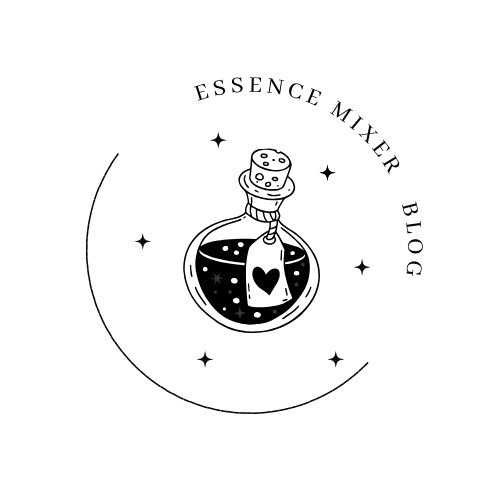To create perfect perfume blends, you'll need to master the fragrance wheel's main families: floral, amber, woody, and fresh notes. Start by combining kindred notes from adjacent families for natural harmony, then experiment with complementary scents from opposite sides of the wheel for depth. Follow the 30-50-20 rule: 30% top notes, 50% middle notes, and 20% base notes. Document your successful combinations as you discover the intricate art of fragrance creation.
Understanding the Main Fragrance Families

When diving into the art of perfume blending, understanding the four main fragrance families serves as your foundation for creating enchanting scents.
You'll find floral notes that capture the essence of blooming flowers like jasmine and rose, perfect for romantic and fresh compositions. The amber family offers rich, warm elements through sweet vanilla and spicy cinnamon, creating an inviting atmosphere in your blends.
If you're seeking depth and earthiness, woody notes like sandalwood and cedar provide the perfect backbone, especially when paired with florals.
For a burst of energy and cleanliness, you'll want to explore fresh fragrances featuring citrus and oceanic elements.
These families work together harmoniously, allowing you to craft unique combinations that reflect your creative vision while maintaining balance and sophistication.
The Science Behind Scent Combinations
Just as an artist understands color theory, mastering the science of scent combinations requires knowledge of the fragrance wheel and its intricate relationships.
You'll discover that kindred notes, found in adjacent fragrance families, work harmoniously together due to their shared characteristics. For example, a Floral top note might blend seamlessly with an Amber accord.
When you're ready to create more sophisticated blends, experiment with complementary notes from opposite sides of the wheel. These contrasting elements add depth and complexity to your fragrance, much like how opposing colors create visual interest.
To achieve a well-balanced perfume, structure your blend in a triangular formation across the wheel, incorporating top, middle, and base notes. This approach guarantees your creation maintains its character while developing beautifully on the skin.
Essential Ingredients for Each Fragrance Category

Every fragrance category boasts signature ingredients that define its distinctive character.
You'll find that floral fragrances capture romance through jasmine and rose, while woody scents ground your blend with rich notes of sandalwood and cedar.
Fresh fragrances invigorate your senses with bright citrus and green elements, and gourmand fragrances comfort you with sweet, edible notes.
- For a romantic floral blend, combine jasmine and peony to create an uplifting experience that's both elegant and memorable.
- To achieve warmth, layer woody scents like vetiver with amber ingredients such as vanilla and benzoin.
- Create revitalizing compositions by mixing bergamot with green notes like bamboo.
- Design indulgent fragrances by incorporating gourmand elements such as caramel and coffee.
Mixing Complementary and Contrasting Notes
You'll find the art of perfume blending comes alive when you understand how to pair adjacent notes for subtle harmony and opposite notes for dramatic contrast.
Whether you choose to mix kindred scents like woody and floral notes or create bold combinations with amber and ozonic families, each approach offers unique possibilities for your signature scent.
To build a truly sophisticated fragrance, try arranging your chosen notes in a triangle formation across the wheel, incorporating top, middle, and base notes that work together to tell your scent story.
Adjacent Vs Opposite Notes
Master perfumers understand that the art of fragrance creation lies in the delicate balance between harmony and contrast.
When you're working with the fragrance wheel, you'll find that adjacent notes naturally complement each other, creating smooth, harmonious blends.
Meanwhile, opposite notes introduce exciting contrasts that add depth and complexity to your perfume creations.
- Adjacent notes, like Amber and Woody scents, blend seamlessly to enhance specific fragrance profiles.
- Opposite notes, such as Amber and Ozonic, create intriguing combinations through their distinct characteristics.
- Use adjacent notes when you want to strengthen a particular scent family or guarantee smooth changes.
- Experiment with opposite notes to develop unique, complex fragrances with unexpected twists.
Creating Depth Through Layers
Building enchanting perfume blends requires a strategic approach to layering complementary and contrasting notes.
You'll achieve the most enthralling results by combining scents that sit opposite each other on the fragrance wheel, like pairing ozonic notes with amber to create intrigue and complexity.
Start with strong base notes, then build your blend by incorporating different fragrances from various families.
Consider creating a triangle formation on the wheel, selecting components that work together to provide depth and longevity.
You can enhance your blend by mixing fresh citrus top notes with warm woody bases, creating a dynamic interplay of scents.
Look for kindred notes that share similar characteristics to maintain harmony, while strategically incorporating contrasting elements to add dimension and interest to your final creation.
Building Your Signature Scent Profile

Begin your signature scent journey by exploring fragrance families like Floral, Woody, Fresh, and Amber to identify which notes truly resonate with your personal style.
You'll want to map out your preferred combinations using the fragrance wheel, which helps you discover both harmonious and contrasting notes that work well together.
Start experimenting with layering techniques, combining top, middle, and base notes that complement each other while documenting your favorite blends to refine your unique fragrance profile.
Identify Your Scent Preferences
Have you ever wondered why certain fragrances instantly captivate you while others leave you indifferent? Understanding your scent preferences begins with exploring the four main fragrance families on the fragrance wheel: Floral, Woody, Fresh, and Amber.
By learning to identify notes within each family, you'll discover patterns in the scents that naturally draw you in.
- Start by sampling different fragrance types from each family, noting which ones spark joy or create positive emotional responses.
- Test adjacent scent families on the wheel to find complementary notes that enhance your preferred fragrances.
- Pay attention to how fragrances evolve on your skin throughout the day.
- Keep a scent diary to track your reactions to various combinations and note which blends resonate most with your personality.
Your signature scent should feel like a natural extension of yourself, reflecting your unique style and character.
Map Your Fragrance Journey
Now that you've identified your scent preferences, mapping your fragrance journey takes your passion for perfumery to new depths.
Start by using the fragrance wheel to explore adjacent scent families that complement your favorite notes. If you love green notes, you might discover exciting connections with aromatic fragrance elements nearby.
Document your explorations systematically, noting how different combinations affect your mood and suit various occasions.
Pay attention to how top notes shift into middle and base notes, creating a complete olfactory story. Each fragrance family offers unique possibilities, so don't hesitate to experiment with contrasting elements.
Test combinations between opposite families on the wheel for unexpected yet harmonious results. As you build your knowledge, you'll develop an intuitive understanding of which notes work together, helping you craft your signature scent with confidence.
Layer Compatible Notes
When layering fragrances to build your signature scent, understanding note compatibility becomes essential for achieving harmony and depth.
Start by identifying complementary notes on the fragrance wheel that naturally enhance each other, like pairing fresh notes with soft floral accords. You'll discover that certain combinations create a more sophisticated and lasting impression.
- Combine kindred notes within the same fragrance family, such as rose with jasmine for a luxurious floral blend.
- Partner fresh notes with light aromatics to create an airy, sophisticated profile.
- Layer soft floral scents with similar intensities to maintain balance.
- Match base notes from complementary families to add dimension.
Remember to document your successful combinations as you experiment, helping you refine your signature scent profile and master the art of fragrance layering.
Advanced Blending Techniques and Ratios

Mastering the art of perfume blending requires understanding precise ratios and advanced techniques that elevate a simple mixture into a sophisticated fragrance.
When working with fragrance wheels, you'll want to follow the 30-50-20 rule: 30% top notes, 50% middle notes, and 20% base notes. This ratio guarantees your creation maintains balance while considering different evaporation rates.
Explore various sub-families within the fragrance wheel to discover complementary notes. You'll find that combining soft adjacent scents creates harmony, while mixing opposite families produces intriguing contrasts.
Always document your blending experiments, recording the specific ratios and combinations you've tried. By tracking your results, you'll develop a deeper understanding of how notes interact and can fine-tune your signature scent over time.
Troubleshooting Common Blending Mistakes
Even experienced perfumers encounter challenges while creating custom blends, but recognizing common mistakes can help you avoid costly missteps.
When working with the fragrance wheel, you'll need to carefully balance your combinations to achieve harmony. For instance, mixing soft oriental scents with green leaves requires precise proportions to prevent overwhelming the senses.
- Too many strong aromatic notes competing for dominance
- Incorrect ratios when combining complementary scents
- Not documenting successful blend proportions for future reference
- Rushing to add more ingredients before allowing the blend to settle
If your blend isn't working, start fresh with smaller quantities and test systematically.
Remember to keep detailed notes of your ratios, and don't hesitate to neutralize an overpowering combination by introducing softer, complementary notes from adjacent fragrance families.
Frequently Asked Questions
How to Create Your Own Fragrance Blend?
Choose your preferred fragrance families, then combine top, middle, and base notes. You'll want to mix complementary scents, track ingredient ratios, and test the blend until you've achieved your desired fragrance profile.
How to Know What Scents Go Together?
You'll find compatible scents by checking the fragrance wheel – pair adjacent families for harmony or opposite ones for contrast. Select notes from top, middle, and base layers to create balanced, sophisticated combinations.
What Is the Ratio for Blending Perfume?
You'll want to follow the 30-50-20 rule: use 30% top notes, 50% middle notes, and 20% base notes. Alternatively, you can use a 3:5:2 ratio for similar balanced results.
What Fragrance Blends Well Together?
You'll find that citrus pairs beautifully with florals, while woody notes complement amber scents. Don't hesitate to mix fresh notes with oriental fragrances, or combine soft florals with musk for balanced blends.
In Summary
Now that you've mastered the fragrance wheel and learned essential blending techniques, you're ready to create your own signature scents. Remember to start with small batches, trust your nose, and don't be afraid to experiment with unexpected combinations. Keep detailed notes of your successful blends, and you'll soon develop an intuitive understanding of how different notes work together. The perfect perfume is just a few drops away.





Leave a Reply